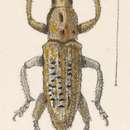Description
provided by INOTAXA archive
Elongate, narrow, piceous; above densely clothed with brown scales, with green and ochreous scales intermixed, the latter mainly confined to the foveiform depressions, the under surface uniformly viridi- squamose, the surface also set with stiff decumbent setæ similar to those on the legs. Head and rostrum densely, finely punctate, the oblique ridges on the rostrum broad and not very conspicuous; antennal scape subclavate at the tip; eyes feebly convex. Prothorax a little longer than broad, cylindrical, narrowed and feebly constricted in front, densely, finely punctate; transversely wrinkled and irregularly foveolate, the disc with two longitudinally placed, small, polished foveæ. Scutellum very small. Elytra elongate, very little wider than the prothorax, subparallel in their basal third, transversely depressed at the base, the humeri oblique, subangular; with rows of moderately coarse punctures placed along extremely fine geminate striæ, the interstices uneven, densely, finely punctate, 3, 5, 7, and 9 widened and more or less raised, the outer striæ coalescent from a little below the base. Legs stout.
Length 14½, breadth 3¾ millim. (♂.)
Champion in: David Sharp & G. C. Champion, Oct. 1911. Biol. Centr.-Amer.,Coleoptera, vol. 4, pt. 3: 281.
- license
- cc-by-3.0
- copyright
- Biologia Centrali-Americana
Distribution
provided by INOTAXA archive
Hab.GUATEMALA, Purula in Vera Paz (Champion).
- license
- cc-by-3.0
- copyright
- Biologia Centrali-Americana
Physical description
provided by INOTAXA archive
One specimen. More cylindrical than M. bifoveatus, the antennal scape more slender, the excavations on the prothorax much shallower, the scutellum smaller, the elytra at the base a little broader than the prothorax, and with the alternate interstices wider and less raised, the under surface uniformly clothed with pale green scales. It is probable that the green scales are partly abraded on the upper surface.
- license
- cc-by-3.0
- copyright
- Biologia Centrali-Americana

